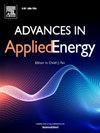Economic viability and CO2 emissions of hydrogen production for ammonia synthesis: A comparative analysis across Europe
IF 13.8
Q1 ENERGY & FUELS
引用次数: 0
Abstract
Ammonia production accounts for 15–20% of greenhouse gas emissions from the chemical sector. Traditionally, ammonia is produced via Steam Methane Reforming (SMR) for hydrogen production, coupled with the Haber-Bosch process. This study compares the SMR-based configuration with emerging alternatives based on water electrolysis – Proton Exchange Membrane Electrolyser Cell (PEMEC) and Solid Oxide Electrolyser Cell (SOEC) – from both economic and CO2 emissions perspective. Process models for the three plant layouts are developed, incorporating heat integration between different components. The economic results are presented in terms of the levelised cost of ammonia, which accounts for both capital and operating expenses over the plant's lifetime. Sensitivity analyses on electricity and methane prices are conducted to assess the cost-competitiveness of each technology across various scenarios. The outcomes reveal that the optimal technology is highly dependent on electricity prices. PEMEC systems are the most cost-effective option at very low electricity prices (approximately 0.02 €/kWhe), while SOEC systems become more competitive as prices rise due to their higher efficiency. Above 0.08 €/kWhe, SMR emerges as the most viable option. Special attention is given to the CO2 emissions from both SMR and electrolyser systems, also considering the carbon intensity of the electricity used. While electrolysis is often assumed to be carbon-free, this research shows that electrolysers can produce more emissions than SMR, depending on the electricity carbon intensity: when carbon intensity exceeds about 260 gCO2/kWhe, SMR results in lower emissions than the electrolyser-based pathways. Finally, future projections suggest that SOEC technology will become highly cost-competitive by 2030–2040.

氨合成氢生产的经济可行性和二氧化碳排放:欧洲的比较分析
合成氨生产占化工行业温室气体排放量的15-20%。传统上,氨是通过蒸汽甲烷重整(SMR)制氢,再加上Haber-Bosch工艺生产的。本研究从经济和二氧化碳排放的角度比较了基于smr的配置与基于水电解的新兴替代方案——质子交换膜电解槽(PEMEC)和固体氧化物电解槽(SOEC)。开发了三种工厂布局的工艺模型,包括不同组件之间的热集成。经济效益体现在氨成本的平稳化方面,这在工厂的生命周期中包括资本和运营费用。对电力和甲烷价格进行敏感性分析,以评估每种技术在各种情况下的成本竞争力。结果表明,最优技术高度依赖于电价。PEMEC系统在非常低的电价(约0.02欧元/千瓦时)下是最具成本效益的选择,而SOEC系统由于其更高的效率,随着电价的上涨,其竞争力将变得更强。在0.08欧元/千瓦时以上,SMR成为最可行的选择。特别关注SMR和电解槽系统的二氧化碳排放,也考虑到所使用的电力的碳强度。虽然电解通常被认为是无碳的,但这项研究表明,根据电力碳强度的不同,电解槽比SMR产生更多的排放:当碳强度超过约260 gCO2/ kwh时,SMR的排放量低于基于电解槽的途径。最后,未来的预测表明,到2030-2040年,SOEC技术将具有高度的成本竞争力。
本文章由计算机程序翻译,如有差异,请以英文原文为准。
求助全文
约1分钟内获得全文
求助全文

 求助内容:
求助内容: 应助结果提醒方式:
应助结果提醒方式:


